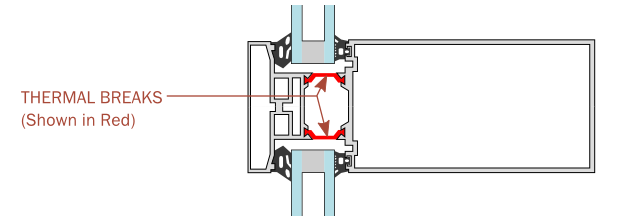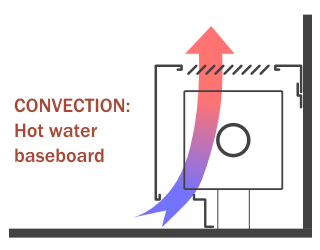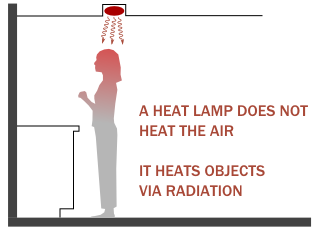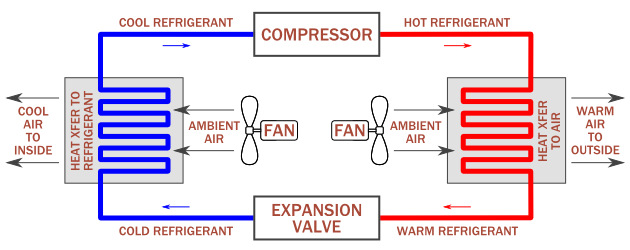No matter what type of climate you live in, controlling the temperature of the air inside of a building is vital to maintaining the comfort of anyone living or working inside.
Whether we are attempting to heat a building or cool a building, heat energy must be moved from one location to another. Heat energy will always follow the rules of thermodynamics: it will move to a cooler place than the location that it is currently located. When hot air enters a room, the items inside the room (furniture, walls, carpet, etc.) will increase in temperature as the hot air decreases in temperature until the point where the temperature of all items inside the room is equal. When heat is pulled from a room (cooling), at some point heat energy will return into the cooler space and will need to be removed again.
There are three ways that heat transfers from one location to another: conduction, convection and radiation.
Conduction
Conduction is the transfer of heat through items that are in direct contact with one another. Given two objects, the particles within the hotter object move more rapidly than those in the cooler object. When the heated object is put in contact with the cooler object, the molecules in the cooler object begin to vibrate faster, which means it is gaining heat energy and becoming warmer. If you were to grasp a metal pole at room temperature with your hand, the pole feels cold due to the fact that heat energy is being transferred from your hand to the pole. The vibration of the molecules in your hand is causing an increase in the vibration speed of the molecules inside the metal, which causes the temperature of the metal to rise and that of your hand to drop. For this reason, we would say that metal is a good conductor.
Building insulation, on the other hand, is not a good conductor. If you were to grab insulation with your hand, it would likely feel warm or neutral, due to the fact that the vibration of the molecules in your hand is not able to cause an appreciable increase in the vibration of the molecules in the insulation. Heating or cooling through conduction typically takes place at the building envelope (the outside walls, windows and doors) where warm or cold air outside causes the molecules of the envelope to increase vibration or decrease vibration which in turn causes a heat loss or gain inside of the building.
An example of conduction affecting building temperature is the transfer of heat energy through the components of a window. Outside air comes in contact with the exterior mullion surface, which transfers energy through the metals and the glass, which transfers the energy to interior finish materials in contact with the mullion. This is the reason that window manufacturers use a thermal break material. The thermal break is a poor conductor so heat energy doesn't move through it as easily. This same principal applies to all building construction - a thermal break is critical in keeping heat energy from being lost to cold outdoor air.

Convection
Convection is the movement of warmer areas of a fluid (liquid or gas) to cooler areas of a fluid. The movement can occur naturally or may be forced through mechanical means. Natural convection occurs in fluids due to the fact that hot fluids will rise through cold fluids since they have a lower density. The cold fluids then sink through the hot fluids. This physical principle is used to great effect in hot-air balloons, which remain aloft through maintaining an air temperature greater than the surrounding atmosphere.
In buildings, convection heating is accomplished through several different means. Hot water and steam radiators, as well as baseboard heaters, utilize convection to transfer heat throughout building spaces. Room air comes in contact with the elements of the heater and receives heat energy. The hot air then rises within the space and creates a circulation pattern within the room. Mechanical means may also be used to force convection to occur -- such as the use of forced air heating in homes and buildings. In this case, heat is generated using a furnace, which employs a fan to force the heated air throughout the building and into individual rooms via ducts. The vents inside the rooms are typically located near floor level, which allows the hot air to rise towards the ceiling and displace the colder air.

Radiation
Thermal (heat) radiation is created by molecular motion within any physical object. As noted above in Conduction, the molecules in an object increase in speed as the object generates more heat. The higher the temperature, the more infrared radiation produced. Infrared radiation travels at the speed of light, is not visible to the human eye, and moves in a straight line from one point to another. The heat energy coming from the sun is an example of radiant heat. Though millions of miles away, we can feel the heat from the sun here on earth, although there is no direct contact. Another example of radiant heat is that generated from warm charcoal, which may be generating a significant amount of heat even if it doesn't give off light.
Heat lamps in residential bathrooms are an example of radiant heat technology used within buildings. Thermal energy is transmitted to people and surfaces in the room that are within the sight lines of the lamp. The heat lamp is not heating the air; rather, UV radiation is directed to an object and warms the surface.

Cooling
Cooling a building involves the same physics as heating. The only difference is that instead of introducing heat into a building space, we are removing heat from the space. This requires the use of slightly different equipment, but the principles are the same. Air-conditioning is the typical means of removing heat from interior spaces and is accomplished using the principles of conduction and the use of a fluid compressor. When a fluid is compressed it releases heat, and when it is at a low pressure it absorbs heat. A refrigerant fluid at low pressure is allowed to circulate within coils that are on the interior side of the building. A fan is then used to pass building air across the coils. Through convection the warm interior air transfers heat energy into the metal that forms the coil, and the metal in the coil transfers its heat energy to the fluid. This fluid is then run through a compressor and passed into the coils on the outside of the building where it releases the heat to the outside air. The cycle continues until the space reaches the desired temperature and the building thermostat signals the air-conditioning unit to shut off.
For more information on building cooling, check out our article that describes how air conditioners work.

Cooling systems introduce additional complexity due to the physical process of condensation. When warm air comes in contact with a surface of lower temperature, the molecules of the air move closer together as it cools. If the temperature drops to the point where the water vapor molecules in the air attract each other and connect, liquid water will form. The point at which this happens is known as the dew point. Condensation is one reason why it is rare to run cold water through a baseboard heating system to help cool the air; you will quickly end up with puddles of water below the coils.
Radiant cooling requires humidity control systems since condensation can form on the cooling surfaces due to the temperature difference between the cool panel and the warmer air. Air humidity sensors and temperature sensors are employed to ensure that the temperature of the indoor air does not fall below its dew point. Dehumidification systems are essential for radiant cooling to be successful.


